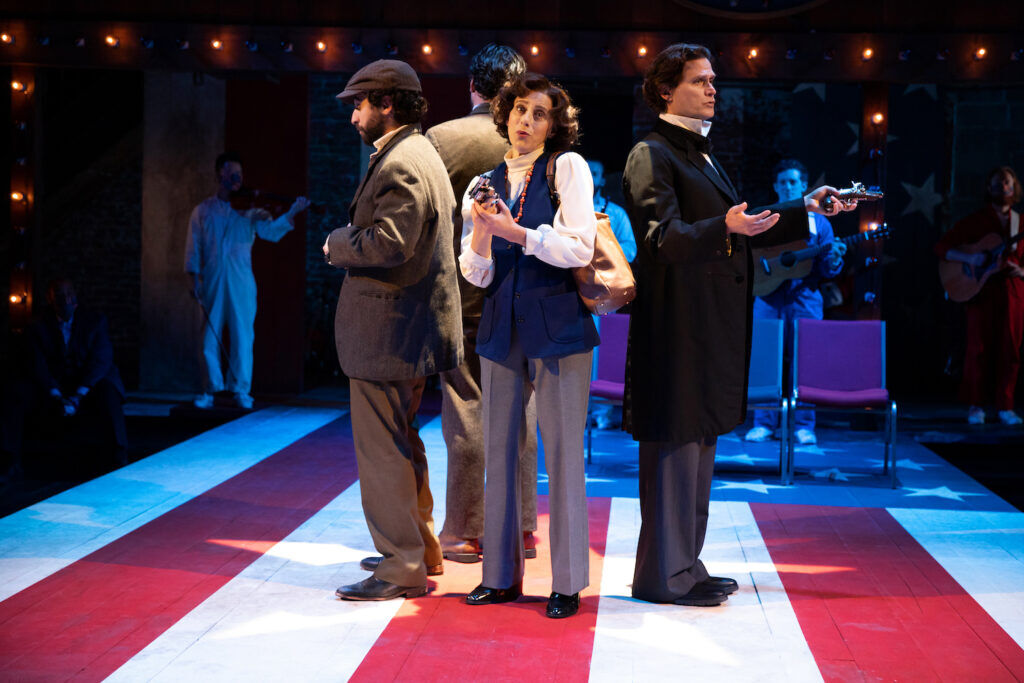This story is part of INTO’s seven-part series, in which we’ve asked queer voices to respond to the surge in gun crime and the sixth anniversary of the Pulse shooting. We hope these varied perspectives encourage dialogue and change to end the needless violence plaguing our country.
“It takes a lot of men to make a gun, hundreds, many men to make a gun.” –Assassins
Feeling both outrage and numbness by the recent mass shootings in Buffalo, Uvalde, Tulsa, Philadelphia and Chattanooga, as well as the forthcoming sixth anniversary of the Pulse nightclub massacre, I’ve retreated to familiar territory to try to make sense of the unimaginable. Musical theater is often seen as a frivolous escape, but Stephen Sondheim—who died last November at 91—has dismantled that theory time and again.
A musical about people who attempted or succeeded in killing an American president? It was a tasked seemingly tailor-made for the musical theater titan. At age 61, Sondheim broke the cardinal rule of “writing what you know” to create “Assassins.” In collaboration with book writer John Weidman, the Tony-winning composer-lyricist created a grim tapestry of The American Dream gone awry. From John Wilkes Booth to John Hinkley, Jr., the creators examined our perception of gun violence through the psychological and cultural influences that morph thought into action.
Related: Why We Need to Say Goodbye to the Romance of the Gun

Martin Gottfried wrote in the retrospective aptly titled Sondheim, “Instead of viewing the assassins as freaks and misfits outside the American experience, the authors saw them as products of it, victims of it, people who misread the guarantee of the right to the pursuit of happiness as the right to be happy.”
With easy access to AR-15 semi-automatic rifles, the weapon used in many of these recent attacks, Sondheim’s lyrics become even more haunting:
And all you have to do
Is
Move your little finger,
Move your little finger and —
You can change the world.
But the world only seems to be changing in one direction: We kill. We grieve. Will kill again. The finger that murders isn’t only the one that pulls the trigger. It’s the one ignorantly jabbing at the opposition like Las Vegas city council member Michelle Fiore, who dismissed the Uvalde shooter and inaccurately labeled him as trans, suggesting: “He was also on a lot of different medications from transgendering. So his mind was quite defective.”
Or Marjorie Taylor Greene, who tweeted to Stoneman Douglas High School survivor David Hogg, “… I hear you & your girls are funded to come to town this week to once again try to manipulate some of my gutless weak colleagues to vote for gun control that will violate our freedoms and leave Americans defenseless.”
One has to wonder: defenseless against what exactly?
Some Day
Sondheim was only 25 years old when he auditioned for Leonard Bernstein to contribute lyrics to West Side Story, a musical adaptation of Shakespeare’s Romeo and Juliet. Though much of the impact comes from Arthur Laurents’ book, Sondheim’s economy of language heightened the musical’s message of racial and socioeconomic disparity and how gun violence could destroy a community within seconds. Steven Spielberg’s 2021 film adaptation explored the concept further, with gang leader Riff (Mike Faist) and peacemaker Tony (Ansel Elgort) struggling for possession of a handgun in a reimagined version of “Cool.”
In an act of revenge, one fatal bullet brings West Side Story to its climactic ending. Spielberg recontextualizes what pushes Chino (Josh Andrés Rivera), now portrayed as a book-smart student with dreams and aspirations of his own, to shoot Tony.
“Hold my hand and we’re halfway there,” sings Maria, clutching Tony as he takes his final breath.
“Hold my hand and I’ll take you there,
Somehow…” they sing together.
Maria is left with overwhelming anger, something that also nearly turns into murderous rage. “How do you fire this?” She asks Chino, taking the gun from him. “Just pull this trigger right here?” Overcome with grief, she wonders aloud how many people she can kill and “still have one [round] left” for herself.
But she doesn’t pull the trigger. In this movie—as in the original—Maria is too smart for that. She knows that violence begets violence.
“Some day!” Maria sings instead, as members from both gangs lift Tony’s lifeless body — a symbol that “some day” might be today — a day where we lift each other instead of tearing one another down.
“Some day” isn’t soon enough for victims or survivors of gun violence. Robb Elementary teacher Arnulfo Reyes tried to protect his students; he was shot twice by an 18-year-old gunman who acquired two assault rifles and 365 rounds of ammunition, even posting his purchase on social media.
“The only thing that I know is that I won’t let these children and my co-workers die in vain,” Reyes told ABC News. “I will go to the end of the world to make sure things get changed. If that’s what I have to do for the rest of my life, I will do it.”
A Weekend in the Country, Global Invasions, and a Way Forward
Sondheim later collaborated with Hugh Wheeler to adapt Ingmar Bergman’s film Smiles of a Summer Night into a musical—the beautiful “A Little Night Music”—with a score primarily written in ¾ time, giving a lilting effect to the plot, which follows several couples as they head to the countryside for a weekend frolic that descends into adultery, deception, and horny hijinx.
Among these weekenders are cavalryman Count Carl-Magnus Malcolm and newly-remarried widower Frederik Egerman, who both desire the glamorous actress Desiree Armfeldt. The count challenges his opposition to a game of Russian roulette, though the single shot only grazes Frederik’s ear.
Sondheim’s earlier collaboration with John Weidman, Pacific Overtures, tells the story of Commodore Matthew Perry and the U.S.’s forced opening of Japan to global trade through the use of gunboat diplomacy. Biographer Gottfried described Sondheim as “downright hostile to political theater.” Yet seen through today’s lens, such works cannot help but reflect similar worldwide conflicts.

Who Lives, Who Dies, Who Tells Your Story
Guns as a plot device have been used and argued for decades. While gun violence considered necessary to tell many stories in certain genres, their presence feels much more real when displayed in a theatre rather than viewed on TV from the living room couch.
In the wake of the Pulse shooting in 2016, producers of Hamilton decided to forego featuring muskets normally used in Andy Blankenbuhler’s choreography at the televised Tony Awards performance. The show’s creator, Lin-Manuel Miranda, who first met Sondheim in high school, thanked him in his Tony Award acceptance speech for In the Heights and later framed an email that congratulated Miranda on a particularly witty lyric, recognized the power of song and performance. Upon winning the Tony for Best Original Score, Miranda delivered a sonnet, which said, in part:
We chase the melodies that seem to find us
Until they’re finished songs and start to play
When senseless acts of tragedy remind us
That nothing here is promised, not one day.
This show is proof that history remembers
We lived through times when hate and fear seemed stronger;
We rise and fall and light from dying embers, remembrances that hope and love last longer
And love is love is love is love is love is love is love is love cannot be killed or swept aside.
Miranda will undoubtedly continue Sondheim’s legacy of truth-telling. The theater holds many powers but none strong enough to hold the weight of our fallen conscience. The right to bear arms will be debated. More will die. And more stories will be told. But will the story we tell ourselves—the outdated and impractical story of bearing arms as civil rights—ever change?
Some may scoff at the idea of a character breaking out in song, but it’s in these moments of heightened emotion that the artform thrives, and where I find solace. A melody can induce emotion; a lyric, empathy. Sondheim’s chapter is now closed but the book is far from complete. The next generation of artists will continue to question and challenge audiences, but if a change is to happen beyond the confines of a darkened theater, then entertainment and action must morph into one.
In Assassins‘ final refrain, the company sings, “Everybody’s got the right to their dreams.”
But at what cost?♦
Help make sure LGBTQ+ stories are being told...
We can't rely on mainstream media to tell our stories. That's why we don't lock our articles behind a paywall. Will you support our mission with a contribution today?
Cancel anytime · Proudly LGBTQ+ owned and operated
Read More in Culture
The Latest on INTO
Subscribe to get a twice-weekly dose of queer news, updates, and insights from the INTO team.
in Your Inbox














